Question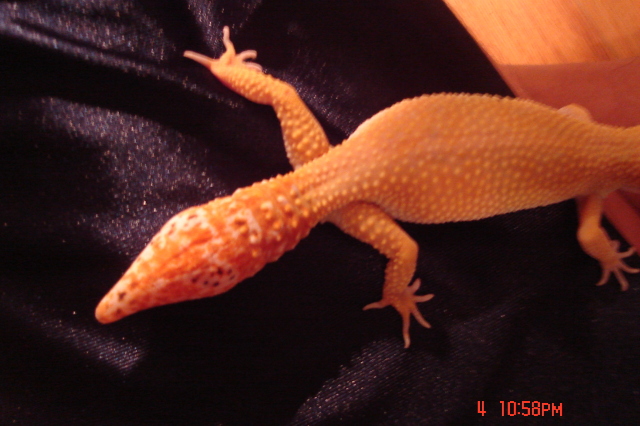 tail
tail
QUESTION: Hi Diane. How are you today? I have a female leopard gecko which stopped eating about 4 or 5 days ago. She is an adult and she laid her last batch of eggs approximately 2 months ago. I can see the layouts of the eggs in her stomach, but i am worried because i read online that females take 10-35 days between each clutch and it has been 2 months now. Is it possible that she decided to stop breeding for a month and then suddenly decided to start again? I feed her mostly mealworms and occasionally crickets. I put a dish of calcium and i powder her crickets and mealworms with vitamin. Her stomach is round and somewhat swollen. I know your not a vet but is it possible she has dystocia? She is still active and alert. I know for sure it isn't impaction because i use paper towel for the substrate. I attached some images and i was wondering, does her tail look healthy or does it look skinny and unhealthy. I do provide a nesting spot for her as well. And i just love my leopard geckos and i hope you can help me out. Thanks so much Diane .I really appreciate it.
ANSWER: Hi John,
I'm fine, thank you for asking.
When comparing the eggs that are in her to the eggs that she carried before, how does the size compare? If they are smaller at this point, I would guess that she isn't ready to lay quite yet. Yep, they say its generally 10-35 days between clutches... but they like to make humans crazy and go outside of the normal sometimes. She may not have formed eggs again right after the last clutch..but even if she did not breed again in that time frame, eggs could still be fertile as they can store sperm. She may also have said "enough eggs" and then the male bred her again. How many clutches has she laid so far this season? How long have you been able to see the eggs in her this time? How old is she?
Are you providing a proper place for her to lay her eggs? How does her tail look compared to what it looked like before breeding season?
I know, lots of questions..but they are questions you need to ask yourself. Many times in answering a few questions for yourself you will come up with the "what to do". To me, she looks a little skinny in the tail base..but I don't know what she looked like before so its really tough to tell for sure. If she is very young (under about a year) then repeated eggs may have her tired out and weakened her health.
If she is straining in any way at all to push out an egg with no success, then a trip is needed to the vet for sure. If her normal activity level is slowed, again, a trip to the vet. If the time frame of when you saw eggs in previous clutches and she laid compared to when you saw the eggs this time is past, then a trip to the vet is needed.
I am a firm believer in males and females having their own tank and only being placed together for a short time for breeding purposes..especially if the male is always wanting to breed. Since I do reptile rescue, yes, I may have a different outlook on breeding.. If your leos eggs are fertile and or have hatched...hopefully you have no problems finding good homes for the babies...... I'm including a basic care sheet that I wrote to help you out..or to print out and give to your "baby buyers" to help them give the leos good homes. In it there are links to more info and also to finding vets in your area.
http://www.thegeckospot.com/leobreeding.html has more things to look for on egg binding...
BASIC CARE FOR A LEOPARD GECKO
Leopards are pretty easy to care for but they do need
special care. Here are some of the basic needs of your gecko.
HOUSING: The need to have at least a 20 gallon long tank for one Leo. This needs to have a secure fitting screen top...they can be quite the escape artists!!! They need to have a humid hide box.You can make this with something as simple as a small plastic dish with a hole cut in one side and a small mesh bag filled with some Sphagnum moss coconut bark or Peat moss that you mist.
I made mine out of the small plastic folgers coffee containers...I cut an opening in the lid..and put the moss in..they LOVE it. I use the terrarium moss in mine.
I use that on the warm side of the tank. Be sure to provide a cool hidebox on the other end. I also provide a mid temperature hide...which is in the middle of the tank.I use the critter caves which you can purchase. NOT the ones that have heat in them!!!!
Provide secure climbing areas for your gecko. Fake plants, rocks and branches are all fine to use. be sure there are no wires or sharp ends to any fake plants you use.
*****SUBSTRATE:(that's the stuff on the floor of your tank) Newspaper, lizard carpet or paper towels work great and are easy to clean and are much safer than any loose substrate. Sand or other loose substrate is not recommended as that they can be deadly to the leo when it is ingested(eaten, even by accident while eating their insects)...A very graphic site of an impacted leo surg can be seen at http://homepage.mac.com/exoticdvm/reptile/PhotoAlbum181.html it is very graphic!!! ******What I have found that works great for safety and heat distribution is using about 1/4 inch of childrens play sand(since the tiles fit tight together, there is no sand danger) on the bottom of the tank and on top that you place ceramic or slate floor tile. What is nice is that the 12 x 12 squares fit perfect in a 20 gallon tank with no spaces between the tiles. The sand and the tile distribute the heat wonderfully. Using the under tank heater as described is what distributes the heat. Also, overhead heat will help in heating the tiles...I've been using this set up for several years and the leos love it. Using a tile that isn't smooth is recommended. **********
TEMPERATURES: They need a warm area of 88-92 degrees and a
cooler area in the upper 70s, low 80s. At night their temperature can drop to the low to mid 70's.
Never use a hot rock for a leopard gecko...or any reptile.
They can severely burn any reptile. You can use a heating
pad under the tank,under tank heater, or you can use a regular household lightbulb in a dome fixture with a ceramic socket in it to keep the warm area at the 88-90 degree area.At night, no white light. If room temperatures stay above 70 degrees, no extra night heat is needed. The undertank heater or heating pad should cover about 1/3 of the tank....be sure to raise the tank up about 1/4-1/2 inch off the stand when using an undertank heat source to prevent heat build up which can cause the glass to break and hot spots in the glass. Be sure to have a good layer of newspaper, carpeting or, even a thin flat rock(such as tile) on top the area that the undertank heat source is placed...if you use a thin rock or tile, it helps to distribute the heat very well.
You can use the special nighttime lights that are designed for reptiles. I like using a ceramic heat emitter on a thermostat for nighttime heat.
DO NOT use black lights or party lights as they can cause eye damage!!!!
The wattage you use will vary based on room temperature and size of tank.
LIGHTING: Leopard geckos do not need UVB lighting but it does not hurt them to give them uvb. They should have some type of light during the day, be it a uvb tube, regular florescent light, reptile day light or regular household lightbulb. NO white lights at night!!!
FEEDING: Geckos should not be fed crickets or other insects that are bigger than the space between their eyes. Generally, hatchlings can be fed more than once a day,juvys can be fed twice a day, adults are fed once daily or every other day, in the early evening. Crickets and other food items such as silk worms, super, and an occasional treat of a wax worm, need to be dusted with a calcium supplement two times a week and also they should have a small dish of calcium in their tank. I use the lid of a milk jug for the little dish of calcium in their tank. For dusting the insects, Use a calcium with no added phosphorus. Insects must be gut loaded(fed) for at least 48 hours prior to feeding your gecko. Remove any uneaten crix or superworms after 15-20 minutes..... Place a piece of cut potato in the tank so that if you have missed any uneaten insects, they will eat the potato instead of nibbling on your gecko!!!
*************You have to be sure to feed your crickets and insects the right foods before feeding them to your gecko. If your crickets/insects are not healthy and well fed, your gecko will not get the nutrition he needs. You can gut load your crickets and insects greens, veggies, cereals or specially designed commercial foods for crickets or the insects you are feeding. ************
Be sure to have a small dish of clean water for your gecko at all times!!
You can offer them some baby food or fruits on occasion ...
Mine will even eat a small piece of watermelon now and then.WATER: always provide a dish of drinking water. If you choose to mist your gecko to drink, its best to not get the tank too wet as that they do not do well with higher humidity. Sometimes its better to take your leo out of their tank to mist them to get them to drink!!!
HANDLING: Some geckos enjoy being held...others prefer not to be handled at all. Be sure to be very gentle when holding your leo and NEVER grab them by the tail! Their tails are extremely fragile and will break.
I do suggest finding a vet that can treat reptiles BEFORE you actually need one!!! To find a vet that is able to care for reptiles:
http://www.anapsid.org/vets
http://www.arav.org/Directory.htm
For more information on leopard geckos:
http://www.thegeckospot.com/leobreeding.html
http://www.drgecko.com
If you have any questions or don't understand something, please let me know.
---------- FOLLOW-UP ----------
QUESTION: Thanks Diane, just to answer your questions, my female leo is probably 1 and a half years old now. Her tail previously was a tad bit bigger and i do provide a nesting place with wettened vermiculite. She did go in there this morning digging, so i hope that means her eggs are close to hatching. I have been able to see the eggs for about a month or so, not exactly sure, maybe longer. So far this season, she laid about 3 or 4 clutches i believe. This is her first breeding season as well. I have one last question, how do i know if she is straining to push her eggs out? Thanks so much for your previous reply and i really do appreciate it.
AnswerHi John,
Usually they will become frantic or lethargic...tired...she may pause and "push" while walking or laying around....you can also peek into the nesting box of shes been in there for a bit and watch her for a bit. She will most likely raise her tail up while pushing. She may also go into frantic digging...which is a good sign that there is a problem.
You may also want to try a warm(about 90-92 degree water) soak if she is in and of of her nesting box.(make the water only deep enough to her elbow when laying flat)..
Have you tried enticing her with some waxworms to eat? Although not a staple due to the high fat content, they may entice her to eat.
Also want to add...make sure she is well hydrated. Mine will lick at watermelon which is a good source of hydration. Try misting her which will generally cause them to lick at the "mist"


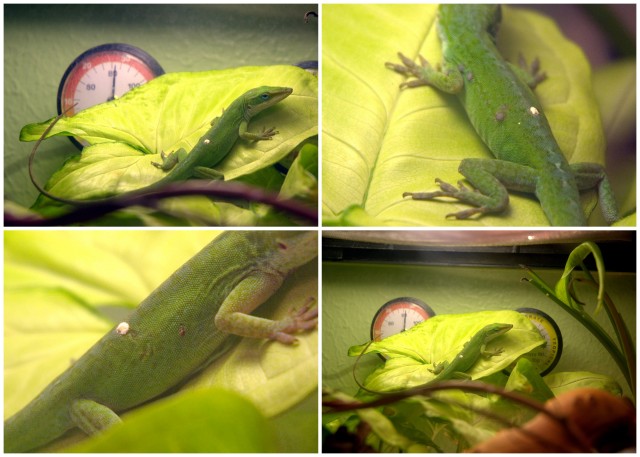 Green Anole with circular lumps
QuestionAnole Collage
QUESTION: I have been keep
Green Anole with circular lumps
QuestionAnole Collage
QUESTION: I have been keep
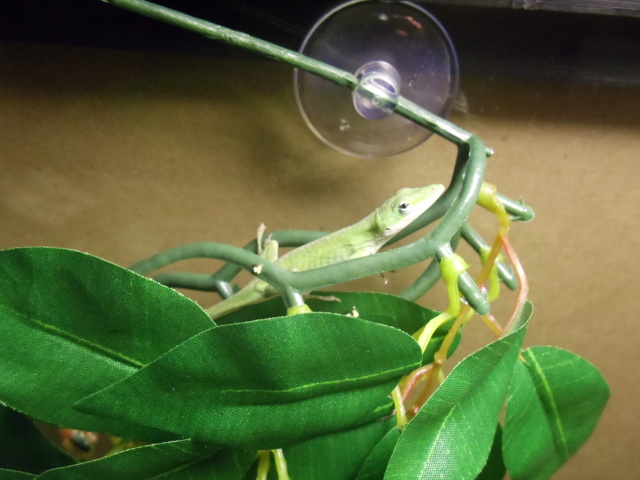 Anole will not eat
QuestionQUESTION: Hi my daughters anole will not eat. W
Anole will not eat
QuestionQUESTION: Hi my daughters anole will not eat. W
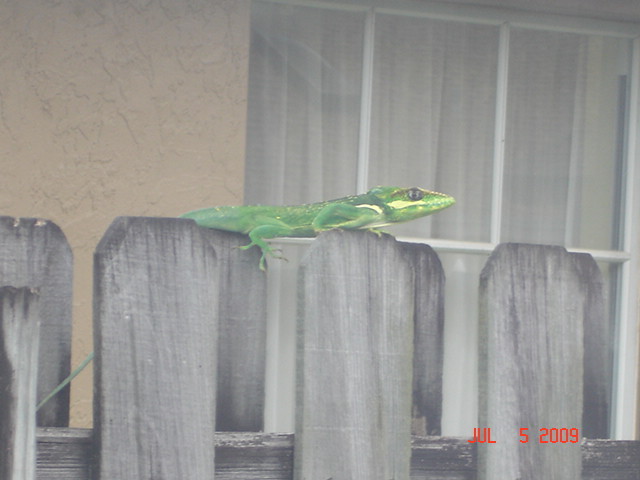 identifying a nonindigenous florida lizard
Question
lizard on fence
i live in a rural community in
identifying a nonindigenous florida lizard
Question
lizard on fence
i live in a rural community in
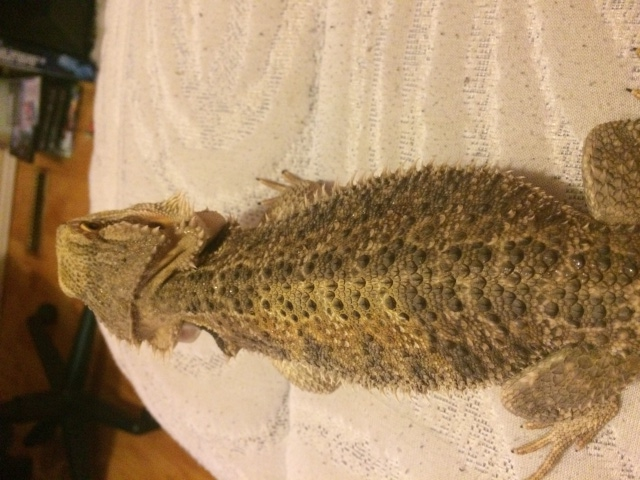 Bearded dragon skin
Question
Luna
My beareded dragon is about a year
Bearded dragon skin
Question
Luna
My beareded dragon is about a year
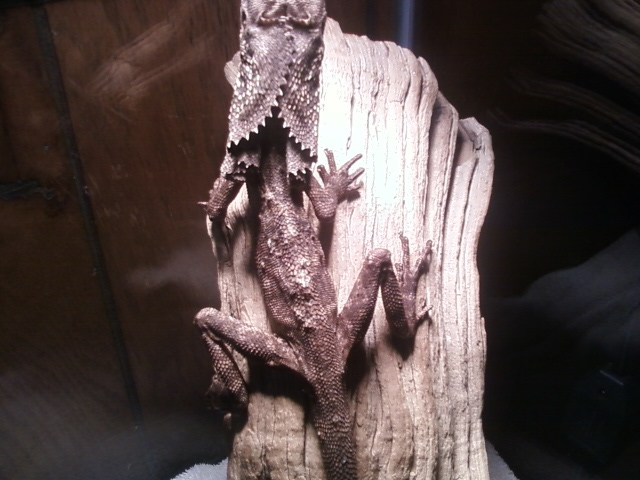 sub-Adult Female Frilled Dragon
QuestionFrilled dragon
frilled dragon
QUE
sub-Adult Female Frilled Dragon
QuestionFrilled dragon
frilled dragon
QUE